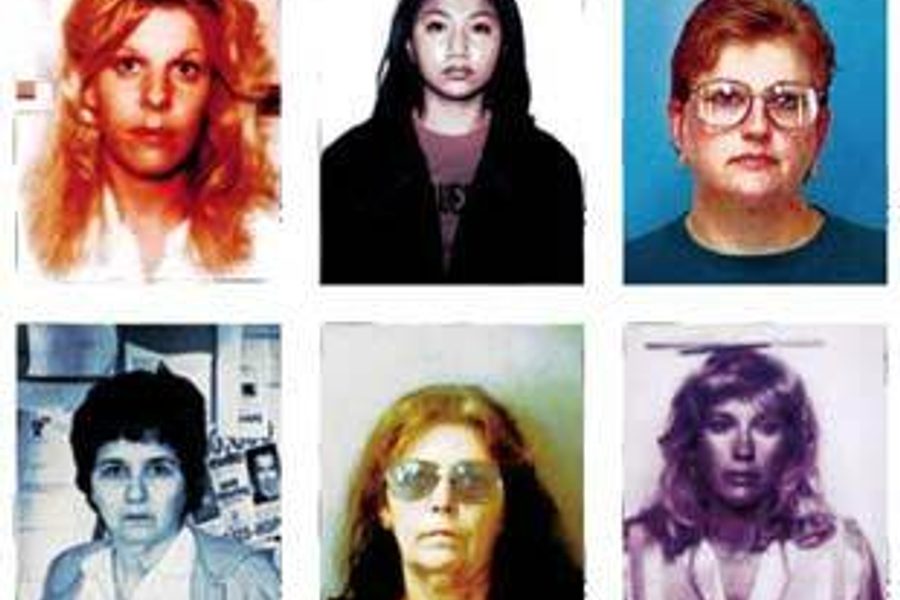
The typical American female TV criminal is nasty, cutthroat, cunning, duplicitous and sexy to boot. Oxygen, a women-oriented cable channel, hypes its popular “Snapped” series this way: “From millionaire brides with everything to lose, to small-town sweethearts who should simply know better, these shocking but true stories turn common assumptions about crime and criminals upside down.”
The show promises to reveal that there is “something far more sinister to the fairer sex than ‘sugar and spice and everything nice.’” As proof, “Snapped” offers up Carolyn Warmus, the daughter of a self-made millionaire. “To put it simply,” Carolyn, a “young temptress” with “blond hair, a voluptuous figure, and sassy personality, got what Carolyn wanted, including men.”
As temptresses do, Carolyn began an affair with a married man. Then “the sexy nymphet … turned her charms on [a] private dick,” who eventually provided her with a silencer-enabled gun.
One dead wife-of-her-lover later, Carolyn Warmus finds herself on trial, “dressed to kill … arriving every day in very short, very tight miniskirts and designer clothes. With her striking good looks, expensive outfits, and murderous persona, Warmus was the embodiment of the ‘femme fatal’: a sexy, dangerous blond bombshell that seemed to step right out of the hardboiled detective films and pulp novels of the ’40s.”
Words that could have been lifted out those colorful paperbacks – this is what passes as entertainment for women?
Other outlets have also joined the fun. E! Entertainment Television’s series, asks viewers to contemplate: “How does a match made in heaven turn into hell on earth?”
In response, E! offers “True Hollywood Stories: Women Who Kill,” in which audiences are introduced to Margaret Rudin, “a gold digger with a dark side,” and Kristin Rossum, who is presumed to have killed her mate “because she had a handsome lover on the side.”
Deeper motives
Are there cunning, narcissistic women who would kill for thrill or profit? Sure. Why not? Someone’s gender doesn’t ascribe ethical character traits, no matter how much essentialist thinkers would like to think otherwise. But the fact is that cold-hearted women who are simply out for themselves are a tiny minority of women doing time for murder – or any other crime.
When women kill their mates, such acts are usually in self-defense – or as a result of longstanding physical and emotional abuse. According to the U.S. Department of Justice Bureau of Justice Statistics (BJS), at least half of all women in prison, including those jailed for nonviolent offences, were abused by spouses before their incarceration.
Unfortunately, even strong evidence of being battered doesn’t do much to help tip the scales of justice in women’s favor. According to Harvard University domestic violence researcher Angela Browne, women who kill men in self-defense – and where there is evidence of severe assault prior to the killing – are acquitted only 25 percent of the time.
On top of this, women who are charged with the murder of their partners have the least extensive criminal records of any group of convicted offenders. Yet the National Coalition Against Domestic Violence reports that the average prison sentence of men who kill their female partners ranges from two to six years, while women who kill their partners are sentenced to an average of 15 years. In states ranging from Florida to South Carolina, many are serving life sentences without the possibility of parole.
In 1993 an Ohio-based research team studying the motivations for murder in intimate relationships found that 82 percent of men in custody who killed female partners or wives did so because they were motivated by “possessiveness,” whereas 83 percent of women in custody described their motivation for murder as “self-defense.”
On programs about women in prison, even the act of self-protection is subject to sensationalizing. Here’s how the producers of “Snapped” pretend to confide in their viewers: “Let’s be honest, we’ve all had at least one moment in which we felt as though we could snap. Even if you’re in the ‘perfect relationship,’ chances are, you’ve probably said (or even just fleetingly thought), ‘I’m going to kill my husband!’ So what separates those of us who do, from those who don’t?”
In one case, “Snapped” did bring viewers a case that reflected the most common reason women kill their partners.
As we learn, Kimberley Kondejewski of Brandon, Manitoba, put up with serious abuse for no less than 17 years from a controlling husband with whom she had two children. When her husband, a military instructor, went so far as to demand that she commit suicide so he could collect the insurance money (with the threat of doing the deed himself and taking out the children in the process), “the meek housewife put a quick and final end to his cruelty.”
Kimberely shot her husband, and then turned the gun on herself. But she didn’t die. Charged with murder shortly thereafter, Kimberely told her story to a jury. That jury, in turn, found that she was not guilty of the charge and sent her home to put her life back together with her children.
Ah, justice.
Ah, Canada.
American justice
It’s rare to see this kind of justice in the United States, where women like Flozelle Woodmore still sit in prison.
Woodmore was 13 years old when she began a relationship with a boyfriend who would end up beating, sexually assaulting and stalking her. Impregnated for the first time at 15, Woodmore was an overwhelmed and severely abused minor without the ability to seek a restraining order – or the know-how to extricate herself from the situation. When she was 18, Woodmore killed her boyfriend, her first and only criminal offense. Information about the abuse was never admitted into court testimony. Woodmore thought she was doing the right thing when she pled guilty, and received a 15-to-life indeterminate sentence. While in prison, Woodmore has become a ‘model prisoner,’ staying clear of infractions, becoming president of an Alcoholics Anonymous group, and earning her G.E.D. Although Woodmore is supported in her plea for parole by the victim’s family, the sentencing judge, and every member of the California Legislative Women’s Caucus, her recommended parole has been denied by a California governor no less than four times.
This past August, California’s Governor Schwarzenegger denied Woodmore parole, reversing the Board of Parole Hearings’ earlier decision to set her free.
Shows like “Snapped” don’t only misrepresent the lives of women like Woodmore, they distort the realities of rising female incarceration. Most women aren’t behind bars because they committed murder. In the United States, the dramatic increase in the female prison population has much to do with decades of ever-more draconian drug laws. (According to the latest findings from the BJS, women were more likely to be in a state prison for a drug offense in 2004, at 32 percent of inmates, than men were, at the rate of 21 percent.)
Nationally, some 200,000 women are now sitting in jails or prisons – more than eight times as many incarcerated women as in 1980. At least 75 percent of these women are mothers. Out of the 7 million Americans under some form of correctional supervision, 1 million are women.
Two eye-opening new books, Nell Bernstein’s All Alone in the World: Children of the Incarcerated and Renny Golden’s War on the Family: Mothers in Prison and the Families They Leave Behind, highlight another byproduct of women’s mass incarceration that has, thus far, been overlooked. As Bernstein and Golden discuss, one in 10 American children have a parent ensnared in the criminal justice system, while one in 33 will go to sleep tonight without being able to see a parent because she or he is behind bars.
Not only do the vast majority of these women in jail or prison leave at least one child behind when they get locked up, they also are more likely than male prisoners to arrive there with serious histories of emotional, sexual and physical abuse at the hands of family members, partners or strangers. Many are already mentally ill, sick, or both, with chronic diseases, including cancer, hepatitis C and HIV, diseases that end up costing taxpayers millions of dollars, and which often result in the end of a prisoner’s life while still incarcerated.
But stereotyping women in prison as “victims” is no more accurate than buying into the “Snapped” line of heartless, conniving, and (literally) back-stabbing vixens who have more than earned their lengthy stays behind bars.
In truth, many imprisoned women are survivors of the most awesome kind, who should be seen for the individuals they are. These women have carved out their own lives, identities and realities for themselves despite tremendous odds. Are these women complicated, and do they suffer just like you and I? Of course. Are they fierce enough to hurt anyone who bares his or her teeth in their general direction? On occasion. But does any of that make for good television?
Actually, it can.
In November, the cable channel BBC America began to broadcast one of Western Europe’s most popular dramas, “Bad Girls,” about the day-to-day life of inmates in a women’s prison.
Now in its seventh season, “Bad Girls” is the brainchild of three women who have been frank about the fact that the show gives them an opportunity to highlight many of the injustices of female incarceration.
“Eighty percent of women in prison are there for nonviolent crimes,” co-producer Eileen Gallagher recently told the New York Times. “[It is] basically our political philosophy that it’s a complete waste of money to lock them up.”
“Bad Girls” has its over-the-top, soap-opera aspects, to be sure. But the rotating cast of characters come into prison as three-dimensional human beings. These fictionalized characters are ethnically diverse, speaking a variety of different regional dialects. Some are lesbians (yes, real same-sex, non-noir love in prison exists), and many are women in their 40s or 50s. One woman battles breast cancer with the support of her fellow prisoners, and most struggle to keep up some kind of relationship with their family and children on the outside. The more vulnerable women in prison have to fend off attacks from aggressive alpha-female prisoners and/or male correctional officers, sometimes unsuccessfully. These women often use drugs – in and out of prison – and many speak openly of having prostituted themselves in very unglamorous ways. As their stories unfold, so do the complex circumstances that lead real-life women to the prison cell they occupy today.
I’ll take “Bad Girls” over “Snapped” any day. Better still, give us an injection of truth-telling about women in prison, in all of its compelling and riveting reality. Television really could be that powerful, if we weren’t so afraid of what it might unleash.
The California Coalition for Women Prisoners has launched a campaign against Oxygen’s “Snapped” series.








